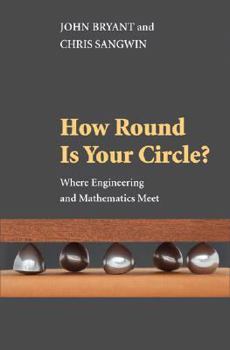How Round Is Your Circle?: Where Engineering and Mathematics Meet
Select Format
Select Condition 
Book Overview
How do you draw a straight line? How do you determine if a circle is really round? These may sound like simple or even trivial mathematical problems, but to an engineer the answers can mean the... This description may be from another edition of this product.
Format:Hardcover
Language:English
ISBN:069113118X
ISBN13:9780691131184
Release Date:January 2008
Publisher:Princeton University Press
Length:320 Pages
Weight:1.20 lbs.
Dimensions:1.1" x 6.0" x 9.3"
Customer Reviews
5 ratings
Original, informative hands-on book
Published by Thriftbooks.com User , 14 years ago
I am an engineer interested in recreational mathematics so it is not surprising the book appealed to me. However, I believe the book will be more than just interesting for a wider technical oriented crowd. I found the topics to be handled with extreme clarity. The examples are abundant and most important of all, the book just makes you want to put it down, jump out of the sofa to the nearest hardware store and build the models described, by yourself. My favorite by far was the chapter on mechanical linkages. One of my better purchases in a while!!
amateur and professional engineers, LOOK!
Published by Thriftbooks.com User , 15 years ago
The review in American Scientist said it beautifully and also included a few of the gorgeous photos of demonstrations created by the two authors. There are blocks that can be piled up so they balance with their tops not over their bottoms. There is a planimeter made from a coat-hanger wire with which to find the area of a plane figure. There is a drill bit that can drill a square hole. Terrific fun at every level from the logo chief to the graduate engineer.
Surprises, Ingenuity and ... a Few Disappointments
Published by Thriftbooks.com User , 15 years ago
This fascinating book flags the spot where engineering and mathematics meet. Each chapter essentially covers a different subject: from linkages to vernier scales to slide rules to balancing dominoes to suspension bridges and so much more. The authors combine the rigidly theoretical approach of mathematics to the very real, practical and physical problems faced in engineering. The result is an amazing romp through various subject areas where the two meet. Very few mathematical derivations are presented here; instead, appropriate references are given throughout (but the reader may feel the urge to attempt some of the derivations him/herself). Some of the results are truly amazing, e.g., stacking a leaning tower of dominoes; some are very ingenious, e.g., the vernier scale and the slide rule; and some chapters I found rather disappointing, e.g., the chapter on suspension bridges - a subject dear to my heart that somehow I felt was lacking. The writing style can be a model of clarity for many chapters while, unfortunately, others seem rather cloudy by comparison; for example, I would place the first (Hard Lines) and seventh (Follow My Leader) chapters in the second category. But overall, the reader is bound to find this book very much worth the read. Those who are likely to relish this book the most would include mathematicians, engineers and serious science buffs. This book could also be used as a supplementary text for related university courses.
Modeling to illustrate mathematics
Published by Thriftbooks.com User , 15 years ago
This book is in the tradition of the famous book "Mathematical Models," by H. Martyn Cundy and A. P. Rollett. It shows how to create models that illustrate particular mathematical laws, and in fact Cundy was consulted, while he was still alive, by the author. It is a worthy successor to Cundy & Rollett's book, concentrating mainly in two areas: linkages to draw straight lines and curves, and constant-breadth shapes, though entering a few other areas. An example of the type of problem this book considers is: How would you construct "the first" protractor or ruler, if there were none already existing? The spirit of the book is the kind of practical thinking that is thought of as engineering, but the mathematics discussed is fundamental. This is a highly recommended book.
Or how trisected is your Angle?
Published by Thriftbooks.com User , 16 years ago
What this book shows you is that you can really understand Mathematics, when you try to build things, even something simple, like cutting a good circle from wood. Many areas of mathematics are discussed that people instinctively feel they understand, such as the roundness of a curve or circle, dividing an angle into 3 equal parts and other interesting Objects De Mathematica. You will find fascinating ways to really model the pythagorean theorem, or gather the sectors of a circle to make an equivalent triangle. There is much to discover between these pages, and Mathematics becomes concrete, objectified, and deeply understood. As another example: "what would a 3 dimensional object that has constant width throughout (based on the tetrahedron) Look like? You can see what this object looks like, when you read the work, and see the model. To add to your understanding, the Authors have constucted Models of the various mathematical principles and ideas, that you can see with your own eyes: such as "two-tip" polyhedrons, and summing the squares of numbers from 1 to n. Reading this book will improve your grasp of mathematics, as well as inspire you to study Engineering, if you havent already. Future Engineers, will be much smarter for having read this great book. Richard H. Pratt, Ph.D.




